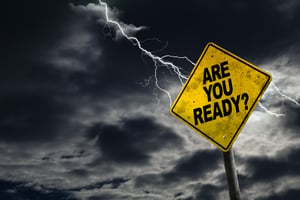Omnilert recently partnered with Campus Safety Magazine on the webinar, “Severe Weather Preparedness: Educating Students, Staff and Faculty on Proper Responses,” featuring meteorologist Dr. Kevin Kloesel from the University of Oklahoma. The webinar raised questions about weather safety practices on university campuses and highlighted how administrators can fulfill their duty of care to ensure the safety of students and visitors. Preparedness for severe weather requires foresight, planning, education, and demands improvement on campuses.
No severe weather threat is limited on one region, and no region faces only one significant threat. Although hurricanes are associated with the East Coast and earthquakes with the West Coast, changing weather patterns over the last decade have caused increases in not only the frequency and supposed “season” of severe weather events, but also expansions of their traditional range. A common pitfall in emergency planning is to focus on dramatic phenomena, such as tornadoes and forest fires, at the expense of other weather systems. The majority of severe weather found on campuses involves lightning strikes, damaging wind, and heat. Although under emphasized in the past, new measures should be taken to ensure all potentially harmful weather receives emergency planning and preparedness.
The key to handling severe weather events is to have a well-informed, specific, and widely distributed plan. The directors of campus safety, college safety officers, and emergency staff should anticipate all eventualities and create plans for common and uncommon weather phenomena. For example, all colleges in coastal areas should have plans for flooding that may result from storm surges, heavy rain, or even a tsunami. Proactively planning for these events costs far less money and lives than the fallout of a campus unprepared for a disaster. Everyday plans should be in place for afflictions, such as strong wind chill, heat, and ice, to ensure students and administrators can act appropriately. These plans should vary in scope, from campus-wide to stadium-specific in the case of special events, and should tackle severe weather events individually -- evacuating a stadium in the case of a lightning storm as opposed to a tornado involve very different procedures.
However, even the best plans fail if people are not aware of them. Distributing information on severe weather practices is crucial to preventing injury and loss of life. For events like concerts, ballgames, and fundraisers, event staff should be aware of severe weather measures and efforts should be made to increase public awareness. For everyday life on campus, students, faculty and staff should be well versed in weather plans that are distributed proactively. Decision charts can help emergency management identify leaders and necessary actions, and staff and faculty should be trained on how to handle weather events.
The best weather plans are well-informed and, in many cases, uninformed weather plans could be ineffective or harmful. Putting students and visitors in danger while trying to get them out of harm’s way can make an institution directly culpable for injury or loss of life. Knowing today’s best practices for weather is crucial. For example, Wet Bulb Globe Temperature takes into account more weather factors than the Heat Index and has a stronger correlation with heat-related illness. Waiting thirty minutes to resume outdoor activities after hearing thunder is outdated. Weather apps and storm prediction centers provide some information, but are unreliable and contain little analysis. Hiring a campus meteorologist is the best way to receive and make use of accurate information. A meteorologist can implement the analytical and informative aspects of severe weather preparedness, serve as educational members of the campus community, and be integrated into emergency systems beyond the abilities of local meteorologists and forecasters.
All college and university officials have a duty of care to the faculty, students, and visitors on their campus and should ensure anyone who enters their campus stays safe no matter the weather. A variety of events take place on college campuses, from classes to summer camps to sports games, but responsibility does not end with a single group or a single semester. COVID-19 has had wide reaching implications for many existing security measures, making now the perfect time to review and restructure severe weather plans on college campuses. The goal of universal safety on campus is achievable with the proper foresight and planning for severe weather events, but flexibility and preparedness are key to reaching that end.
Getting emergency notifications to students and visitors is equally important. People react differently to severe weather based on factors outside of administrators' control, such as their personal background and disposition. However, emergency notification systems allow campus safety officers to provide crucial information to students and visitors to get them to take severe weather seriously. When a weather event occurs and the National Weather Service does not send out warnings, such as extreme temperatures, a university-specific emergency notification system is the most reliable way to make people aware of the danger.
Click here to read the 7 Steps to Selecting an Emergency Notification Provider Whitepaper

